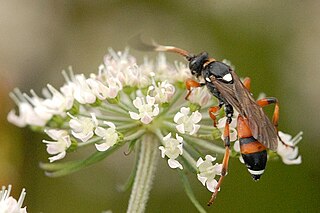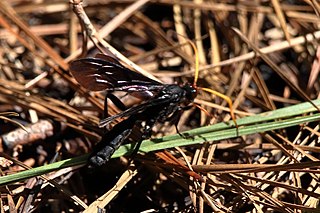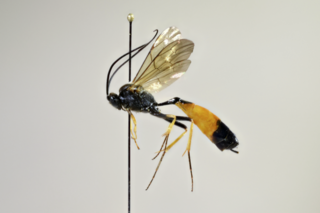
The Ichneumonidae, also known as ichneumon wasps, ichneumonid wasps, ichneumonids, or Darwin wasps, are a family of parasitoid wasps of the insect order Hymenoptera. They are one of the most diverse groups within the Hymenoptera with roughly 25,000 species described as of 2016. However, this likely represents less than a quarter of their true richness as reliable estimates are lacking, along with much of the most basic knowledge about their ecology, distribution, and evolution. It is estimated that there are more species in this family than there are species of birds and mammals combined. Ichneumonid wasps, with very few exceptions, attack the immature stages of holometabolous insects and spiders, eventually killing their hosts. They thus fulfill an important role as regulators of insect populations, both in natural and semi-natural systems, making them promising agents for biological control.

Ichneumoninae is a worldwide subfamily of the parasitic wasp family Ichneumonidae.

Xanthocryptus novozealandicus, the lemon tree borer parasite, is a wasp in the family Ichneumonidae. It is a native insect of New Zealand. It is also found in Australia and New Guinea. Females hunt for larvae of wood-boring beetles around March, including the lemon tree borer, a native cerambycid that tunnels into citrus trees, grapes and many native species. When a suitable host is found, the female pushes her ovipositor through the wood and injects her eggs into the grub. This has the incidental benefit of helping to control some pests. X. novozealandicus prefers to prey on second year lemon tree borer larvae. This specific parasite prefers to prey on larger second year larvae due to its larger size.

Rhyssa persuasoria, also known as the sabre wasp, is a species belonging to the family Ichneumonidae subfamily Rhyssinae. Members of this subfamily, including those of Rhyssa and the allied Megarhyssa, are also known collectively as giant ichneumonid wasps or giant ichneumons.

Ichneumon sarcitorius is a species of wasp belonging to the family Ichneumonidae subfamily Ichneumoninae.

Cratichneumon coruscator is a species of the parasitic wasp family Ichneumonidae.

The Thynnidae are a family of large, solitary wasps whose larvae are almost universally parasitoids of various beetle larvae, especially those in the superfamily Scarabaeoidea. Until recently, the constituents of this family were classified in the family Tiphiidae, but multiple studies have independently confirmed that thynnids are a separate lineage.

Pimpla rufipes, the black slip wasp, is a species of wasp belonging to the family Ichneumonidae. It is distributed across Europe, Asia, and northern Africa.

Trogus is a genus of parasitoid wasp found in the Holarctic and Neotropic regions. It is placed in the subfamily Ichneumoninae and the tribe Ichneumonini. Trogus species are parasites of larvae and pupae of the swallowtail butterfly family, Papilionidae. The genus consists of twelve extant and one extinct species.

Therion circumflexum is a species of ichneumon wasp in the family Ichneumonidae.

Gnamptopelta obsidianator is a species of wasp in the family Ichneumonidae and the only species in the monotypic genus Gnamptopelta.

Dusona falcator is a large species of parasitic wasp belonging to the family Ichneumonidae, subfamily Campopleginae. It is a parasitoid of the buff-tip moth. It is one of the largest known species of Camopleginae, able to reach sizes over 20mm. The species can be found throughout the Palearctic realm.
Dusona admontina is a species of parasitic wasp belonging to the family Ichneumonidae, subfamily Campopleginae. It is a parasitoid of the larvae of Herminia grisealis.
Dusona abdominator is a species of parasitic wasp belonging to the family Ichneumonidae, subfamily Campopleginae.
Dusona aemula is a species of parasitic wasp belonging to the family Ichneumonidae, subfamily Campopleginae. It is a parasitoid of Geometrid moth larvae, mainly Eupithecia species.
Dusona juvenilis is a species of parasitic wasp belonging to the family Ichneumonidae, subfamily Campopleginae. It is a parasitoid of Eupithecia haworthiata larvae.

Dusona leptogaster is a species of parasitic wasp belonging to the family Ichneumonidae, subfamily Campopleginae. It is a parasitoid of Geometrid moth larvae, the two known hosts being Alsophila aescularia and Lomaspilis marginata.
Dusona nidulator is a species of parasitic wasp belonging to the family Ichneumonidae, subfamily Campopleginae. It is a parasitoid, but the host is unknown.
Dusona terebrator is a species of parasitic wasp belonging to the family Ichneumonidae, subfamily Campopleginae. It is a parasitoid of Noctuid moth larvae.

Listrodromus nycthemerus, the holly blue Darwin wasp, is a species of ichneumon wasp belonging to the family Ichneumonidae. This species is a parasitoid, its sole host species being the holly blue butterfly.















